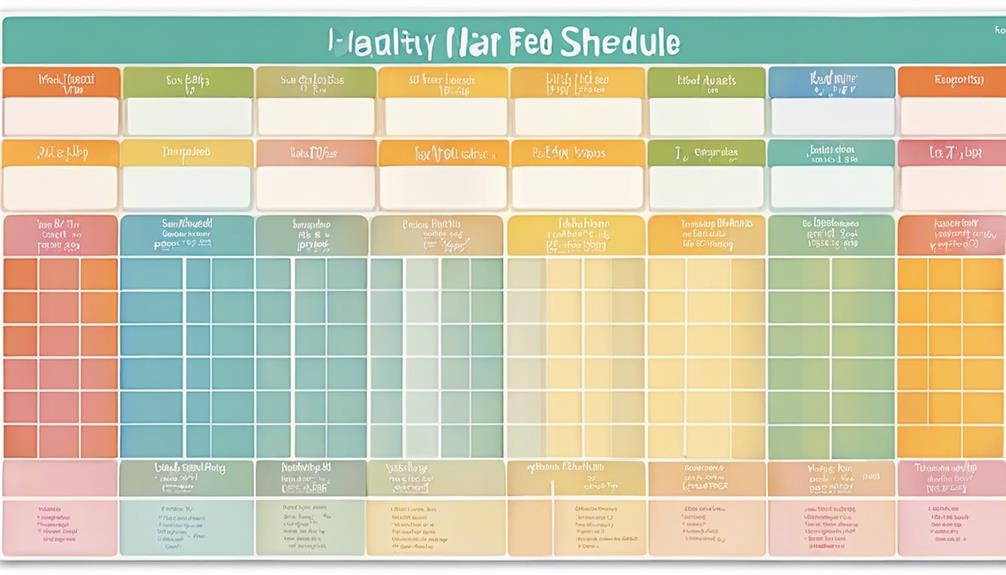As we navigate the intricate rhythm of raising our young children, envision a seamless routine where every serving of formula provided is a step towards their growth and joy.
But how do we strike that balance between nourishment and excess, ensuring our 3-month-old thrives?
Join us as we uncover the intricacies of a formula feeding schedule tailored for your baby's needs, disclosing the secrets to a well-fed and satisfied infant.
Key Takeaways
- Feed your 3-month-old baby every 3-4 hours during the day to meet nutritional needs.
- Offer around 4-6 ounces of formula per feeding to support growth and development.
- Monitor baby's cues for hunger or fullness to adjust the feeding schedule accordingly.
- Consult with a pediatrician for personalized guidance on feeding amounts and frequency.
Establishing a Routine
To begin establishing a routine for your 3-month-old's formula feeding schedule, observe and respond to your baby's hunger cues and patterns. Understanding your baby's needs is critical during these initial weeks after birth. Babies have tiny stomachs that need frequent but small feedings. It's vital to feed your baby on demand to make sure they're getting enough nutrition to support their growth and development.
As your baby grows, their stomach capacity will increase, and you may notice longer stretches between feedings. However, maintaining flexibility and adjusting the feeding times accordingly is important. Babies between 2-4 months may naturally drop middle-of-the-night feedings, but each baby is unique, so pay attention to your little one's cues.
Consistency is key in establishing a successful feeding routine, but being responsive to your baby's individual needs is equally important. By observing and adapting to your baby's hunger cues, you can create a feeding schedule that works best for both of you.
Understanding Baby's Hunger Cues

Understanding a baby's hunger cues is essential for responsive feeding and ensuring their nutritional needs are met effectively. Babies communicate their hunger through various cues, with some being early indicators and others more urgent signals. It's important to pay attention to these cues to avoid waiting until the baby is overly hungry and upset. Here are some common hunger cues parents can look out for:
| Early Hunger Cues | Late Hunger Cues |
|---|---|
| Increased alertness | Crying |
| Turning towards breast | Clenched fists |
| Sucking on fists | Agitated body |
| Making sucking noises | Rooting movements |
Feeding Frequency and Amount
Moving on to feeding frequency and amount, it's important to keep track of how often and how much a baby is fed to guarantee their nutritional needs are being met effectively.
- Monitor Feeding Cues: Watch for signs of hunger like rooting, sucking motions, or putting hands to the mouth to feed on demand.
- Consistent Feeding Schedule: Aim for feeding every 2-4 hours during the day, adjusting as needed to make sure the baby is satisfied.
- Quantity Guidelines: For a 1-month-old baby, offer 2-4 ounces of infant formula per feeding, increasing gradually with growth.
- Total Daily Intake: Strive for 6-8 feedings per day, with a total daily intake of around 2½ ounces per pound of body weight to support healthy development.
Nighttime Feeding Strategies

Observing your baby's nighttime feeding patterns can provide valuable insights into their nutritional needs and sleep routines. Some babies naturally drop nighttime feedings around 2-4 months of age. To support this change, consider gradually reducing nighttime feedings by offering smaller amounts or increasing daytime feedings.
Ensuring your baby gets enough to eat during the day can help minimize nighttime hunger. Implementing a consistent bedtime routine can also aid in establishing healthy sleep patterns. If nighttime feedings are affecting your baby's sleep or growth, seeking advice from a pediatrician is recommended.
Your pediatrician may suggest specific strategies to help your baby get enough nutrition during the day, which can in turn reduce the need for nighttime feedings. By being attentive to your baby's cues and working closely with your healthcare provider, you can develop effective nighttime feeding strategies that support your baby's overall well-being.
Adapting the Schedule as Baby Grows
As babies grow, it's important to adjust their feeding schedule based on their cues and growth spurts to confirm they're receiving adequate nutrition.
Here are some key points to consider when adapting the feeding schedule for a baby who's moving from liquid to solid foods at around 6 months of age:
- Gradually Increase Feeding Amounts: As your baby grows, their appetite will likely increase. Gradually increase the amount of formula offered during each feeding to meet their changing nutritional needs.
- Offer Additional Feedings or Snacks: If your baby seems hungry between regular feedings, consider offering additional feedings or healthy snacks to make sure they're getting enough nutrients throughout the day.
- Monitor Weight Gain and Development: Keep an eye on your baby's weight gain and overall development to make sure that the feeding schedule is meeting their needs for growth and health.
- Consult with Pediatrician: To get guidance on modifying the feeding schedule as your baby moves to solid foods to make sure they're receiving the right balance of nutrients at this important stage of development.
Frequently Asked Questions
What Is the Feeding Schedule for a 1 Month Old Formula?
We feed our 1-month-old formula every 2-3 hours, around 8-10 times a day, with 2-4 ounces per feeding. Watch for hunger cues like rooting. Adjust schedule by baby's signals and guarantee steady weight gain per doctor's advice.
How Do You Make a Formula Feed Step by Step?
Here's how we do it: First, disinfect the area and wash hands. Add water, then measure formula following instructions. Shake well, cool under cold water, test temperature. Follow NHS guidelines for baby's safety.
What Is the Routine for Formula-Fed Babies?
As parents, we establish a feeding routine for formula-fed babies by observing hunger cues and patterns. Babies typically consume 2½ ounces of formula per pound of body weight daily, not exceeding 32 ounces in 24 hours. Prevent overfeeding to avoid issues like obesity.
How Do You Feed a Baby Step by Step?
We feed our babies by preparing formula correctly, holding them semi-upright, offering the bottle gently, watching for feeding cues, and burping them after. Following these steps guarantees safe and comfortable feeding experiences for our little ones.
Conclusion
To sum up, follow baby's cues and trust the signs they choose. Feed with love, not in excess, and avoid a feeding mess.
Nighttime strategies should be adjusted as baby's size varies. Establish a routine to ensure that baby's needs are nourished.
Remember, flexibility is key. Observe, adapt, and baby will be happy and free.
Trust the process and watch them grow. With love and care, they'll continue to glow.










